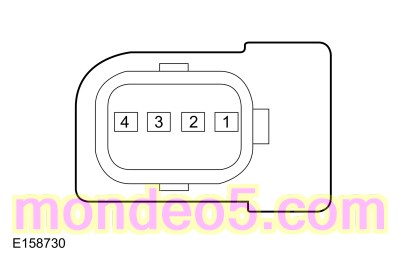- Check the location of the passive key. If it is placed in the far corners of the interior of the vehicle, move the passive key out of these areas and attempt to start the vehicle.
Does the vehicle start (ready to drive displays in the message center for hybrid vehicles)?
| Yes | The system is OK. INFORM the customer of the normal vehicle operation. |
| No | GO to A2 |
- Check for the use of a charger or other wireless device that can cause interference with the passive key. If any device is found, remove the device and attempt to start the vehicle.
Does the vehicle start (ready to drive displays in the message center for hybrid vehicles)?
| Yes | The system is OK. INFORM the customer of the normal vehicle operation. |
| No | GO to A3 |
NOTE: For a concern with key programming or if unable to start the vehicle with the passive key in the back up slot, follow the diagnostics for the PATS center antenna.
- Ignition ON.
- Using a diagnostic scan tool, perform the BCM self-test. Record the DTC .
- Ignition OFF.
- Disconnect suspect antenna.
-
Measure:
PATS Center Antenna ( DTC B10C8:01)
Positive Lead Measurement / Action Negative Lead  C3513, pin 1, component side
C3513, pin 1, component side

 C3513, pin 2, component side
C3513, pin 2, component side
Keyless Entry Rear Antenna ( DTC B10C7:01)
Positive Lead Measurement / Action Negative Lead  C4082, pin 1, component side
C4082, pin 1, component side

 C4082, pin 2, component side
C4082, pin 2, component side
Driver Exterior Front Door Handle ( DTC B11CA:01)
Positive Lead Measurement / Action Negative Lead  C543, pin 2, component side
C543, pin 2, component side

 C543, pin 3, component side
C543, pin 3, component side
Passenger Exterior Front Door Handle ( DTC B11C6:01)
Positive Lead Measurement / Action Negative Lead  C634, pin 2, component side
C634, pin 2, component side

 C634, pin 3, component side
C634, pin 3, component side
Is the resistance between 1 and 3 ohms?
| Yes | GO to A4 |
| No |
INSTALL a new antenna in question. For the
PATS
center antenna,
REFER to: Passive Anti-Theft System (PATS) Center Antenna (419-01C Passive Anti-Theft System (PATS) - Vehicles With: Push Button Start, Removal and Installation). For the keyless entry rear antenna, REFER to: Keyless Entry Rear Antenna (501-14 Handles, Locks, Latches and Entry Systems, Removal and Installation). For either front door exterior handle, REFER to: Exterior Front Door Handle (501-14 Handles, Locks, Latches and Entry Systems, Removal and Installation). |
- Disconnect BCM C2280G (center PATS antenna).
- Disconnect BCM C2280E (keyless entry rear antenna or exterior front door handle).
-
Measure:
PATS Center Antenna
Positive Lead Measurement / Action Negative Lead C3513-1 
Ground C3513-2 
Ground
Keyless Entry Rear Antenna
Positive Lead Measurement / Action Negative Lead C4082-1 
Ground C4082-2 
Ground
Driver Exterior Front Door Handle
Positive Lead Measurement / Action Negative Lead C543-2 
Ground C543-3 
Ground
Passenger Exterior Front Door Handle
Positive Lead Measurement / Action Negative Lead C634-2 
Ground C634-3 
Ground
Is any voltage present?
| Yes | REPAIR the affected circuit. |
| No | GO to A5 |
-
Measure:
PATS Center Antenna
Positive Lead Measurement / Action Negative Lead C3513-1 
Ground C3513-2 
Ground
Keyless Entry Rear Antenna
Positive Lead Measurement / Action Negative Lead C4082-1 
Ground C4082-2 
Ground
Driver Exterior Front Door Handle
Positive Lead Measurement / Action Negative Lead C543-2 
Ground C543-3 
Ground
Passenger Exterior Front Door Handle
Positive Lead Measurement / Action Negative Lead C634-2 
Ground C634-3 
Ground
Are the resistances greater than 10,000 ohms?
| Yes | GO to A6 |
| No | REPAIR the affected circuit. |
-
Measure:
PATS Center Antenna
Positive Lead Measurement / Action Negative Lead C3513-1 
C2280G-40 C3513-2 
C2280G-27
Keyless Entry Rear Antenna
Positive Lead Measurement / Action Negative Lead C4082-1 
C2280E-16 C4082-2 
C2280E-15
Driver Exterior Front Door Handle
Positive Lead Measurement / Action Negative Lead C543-2 
C2280E-13 C543-3 
C2280E-28
Passenger Exterior Front Door Handle
Positive Lead Measurement / Action Negative Lead C634-2 
C2280E-12 C634-3 
C2280E-29
Are the resistances less than 3 ohms?
| Yes |
INSTALL a new antenna in question. For the
PATS
center antenna, INSTALL a new
PATS
center antenna.
REFER to: Passive Anti-Theft System (PATS) Center Antenna (419-01C Passive Anti-Theft System (PATS) - Vehicles With: Push Button Start, Removal and Installation). For the keyless entry rear antenna, INSTALL a new keyless entry rear antenna. REFER to: Keyless Entry Rear Antenna (501-14 Handles, Locks, Latches and Entry Systems, Removal and Installation). For either front door exterior handle, REFER to: Exterior Front Door Handle (501-14 Handles, Locks, Latches and Entry Systems, Removal and Installation). TEST the system for normal operation. If the concern is still present, GO to A7 |
| No | REPAIR the affected circuit. |
- Disconnect and inspect all of the BCM connectors.
-
Repair:
- corrosion (install new connectors or terminals, clean module pins)
- damaged or bent pins - install new terminals/pins
- pushed-out pins - install new pins as necessary
- Reconnect all the BCM connectors and make sure they seat and latch correctly.
- Operate the system and determine if the concern is still present.
Is the concern still present?
| Yes |
CHECK
OASIS
for any applicable Technical Service Bulletins (TSBs). If a
TSB
exists for this concern, DISCONTINUE this test and FOLLOW
TSB
instructions. If no Technical Service Bulletins (TSBs) address this concern, INSTALL a new
BCM
.
REFER to: Body Control Module (BCM) (419-10 Multifunction Electronic Modules, Removal and Installation). |
| No | The system is operating correctly at this time. The concern may have been caused by module connections. Address the root cause of any connector or pin issues. |